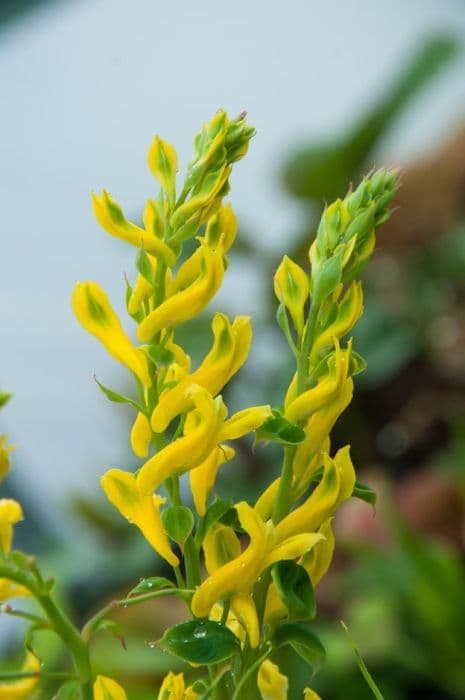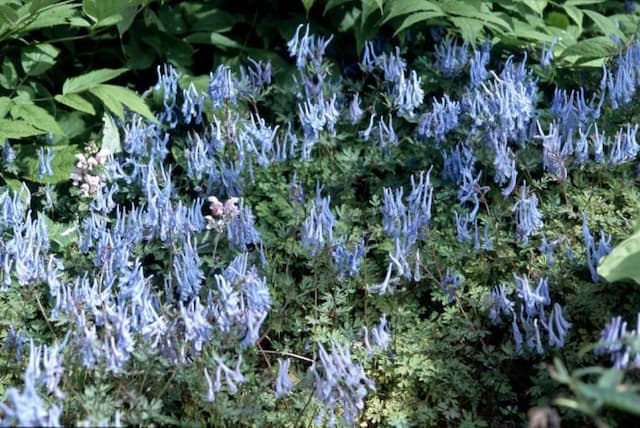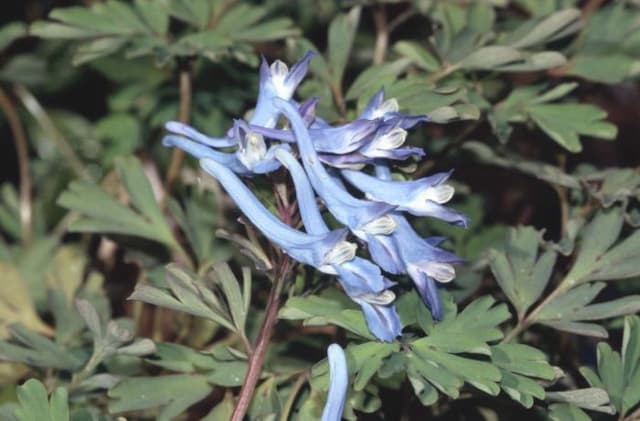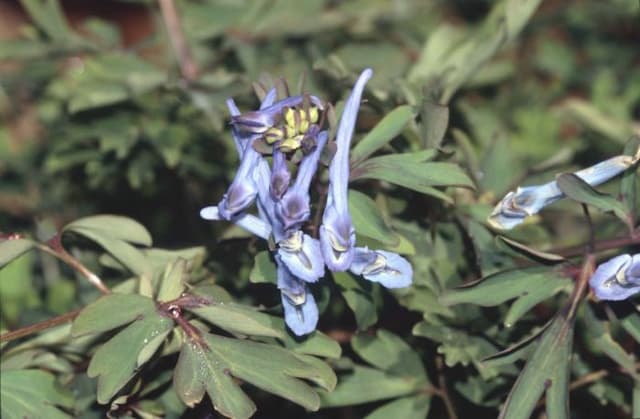Blue Poppy Meconopsis (George Sherriff Group) 'Susan's Reward'

ABOUT
Meconopsis 'Susan's Reward', commonly known as the "Blue Poppy", is renowned for its stunning flowers that display a captivating shade of blue, a color relatively rare in the plant kingdom. The blooms of this poppy are visually striking with their saturated blue petals that exhibit a delicate satin-like sheen. Each flower features a central boss of golden-yellow stamens that contrast vividly against the blue, lending a richness and depth to the overall aesthetic. The leaves of 'Susan's Reward' form a rosette at the base of the plant, with foliage that is lanceolate in shape, often exhibiting a soft, downy texture. The leaves can possess a muted green hue with a subtle silvery sheen, which complements the vibrancy of the blooms. The stems are singular and upright, typically rising above the leafy base to elevate the flowers for optimal viewing. As a member of the George Sherriff Group of Blue Poppies, 'Susan's Reward' inherits a robust nature and resilience, making it a sought-after cultivar among garden enthusiasts who desire the elusive blue blossoms of the poppy family in their gardens. The overall appearance of this plant exudes a sense of serenity and cool elegance, making it an alluring addition for areas that benefit from a touch of unique, natural beauty.
About this plant
 Names
NamesFamily
Papaveraceae
Synonyms
Tibetan Blue Poppy, Himalayan Blue Poppy
Common names
Meconopsis 'Susan's Reward'.
 Toxicity
ToxicityTo humans
The Himalayan blue poppy (Meconopsis betonicifolia), while known for its striking blue flowers, does not have a reputation for being toxic to humans. There is little to no information available that suggests the commonly named Himalayan blue poppy or any of its cultivars, including 'Susan's Reward', are poisonous when touched or ingested. Thus, no symptoms of poisoning are generally documented. However, it is always advisable to exercise caution and avoid ingesting parts of ornamental plants as a general safety measure, particularly in the absence of comprehensive toxicity data. Additionally, individuals with plant allergies or sensitivities should handle plants with care to avoid potential allergic reactions.
To pets
Himalayan blue poppy is not commonly listed as toxic to pets. There is a lack of specific information regarding the toxicity of Meconopsis (George Sherriff Group) 'Susan's Reward' to pets, but the Himalayan blue poppy, in general, is not noted for toxicity. In the absence of toxicity data, it is still prudent for pet owners to prevent pets from ingesting plants, as individual animals may have unique sensitivities or allergic reactions. If a pet does ingest part of a plant and shows signs of distress, it is essential to consult a veterinarian.
 Characteristics
CharacteristicsLife cycle
Perennials
Foliage type
Deciduous
Color of leaves
Green
Flower color
Blue
Height
4 feet (1.2 meters)
Spread
1 foot 6 inches (0.45 meters)
Plant type
Herb
Hardiness zones
5
Native area
Himalayas
Benefits
 General Benefits
General Benefits- Attractive Blooms: Meconopsis 'Susan's Reward' provides stunning blue or purple poppy-like flowers that add striking color and visual interest to any garden setting.
- Unique Foliage: The plant features hairy green leaves, adding textural contrast in garden plantings.
- Wildlife Attraction: The vibrant flowers attract pollinators such as bees and butterflies, which are beneficial for pollination of gardens.
- High Altitude Adaptation: As part of the George Sherriff Group, this Meconopsis is often suitable for high-altitude gardens where other plants may struggle.
- Garden Focal Point: Due to its distinctive appearance, it can serve as an excellent focal point in a diverse garden arrangement.
- Seasonal Interest: Bloom time in late spring to early summer provides seasonal interest during a time when many other plants are not yet in peak bloom.
- Limited Spread: Unlike some other garden plants, Meconopsis 'Susan's Reward' does not typically spread aggressively, making it easier to manage in a cultivated garden space.
 Medical Properties
Medical PropertiesThis plant is not used for medical purposes.
 Air-purifying Qualities
Air-purifying QualitiesThis plant is not specifically known for air purifying qualities.
 Other Uses
Other Uses- Himalayan Blue Poppy 'Susan's Reward' can be used as a natural dye. The petals of the flower can be boiled to extract pigment for coloring wool, silk, or other natural fibers.
- The striking blue flowers can be used in floral arrangements or as a natural confetti at weddings and celebrations, with the petals adding a vibrant splash of color.
- This variety of Meconopsis can serve as an educational tool in botanic gardens or schools to illustrate high-altitude plant species or to demonstrate the biodiversity of the Himalayan flora.
- Due to its intricate beauty, the Himalayan Blue Poppy can serve as inspiration for artists and photographers looking to capture the vividness and uniqueness of the petals.
- The plant can be utilized in mindfulness and meditation gardens, where its calming blue hues contribute to a serene atmosphere for relaxation and contemplation.
- In large public gardens, Meconopsis 'Susan's Reward' can be used to create themed garden sections that highlight plants from different regions of the world.
- As a relatively rare plant in gardens, it can be used to attract and increase visitors' interest in private and public botanical collections.
- Beekeepers in suitable climates may plant Himalayan Blue Poppies to provide an additional nectar source for honeybees, especially in late spring to early summer.
- With symbolic meanings such as 'dreaming' or 'reverie', the Himalayan Blue Poppy can be an element in symbolic gardens or spaces designed for reflection and remembrance.
- The plant's unique color and structure can be used as a teaching subject in horticultural courses, helping students learn about plant breeding and the challenges of growing specific species.
Interesting Facts
 Feng Shui
Feng ShuiThe Himalayan Blue Poppy is not used in Feng Shui practice.
 Zodiac Sign Compitability
Zodiac Sign CompitabilityThe Himalayan Blue Poppy is not used in astrology practice.
 Plant Symbolism
Plant Symbolism- Rarity: The Meconopsis, commonly known as Blue Poppy, is a rare and elusive plant that symbolizes the pursuit and appreciation of unique beauty.
- Peace: Its serene blue hues are often associated with tranquility, calmness, and a peaceful state of mind.
- Dreams: The dreamy appearance of the Blue Poppy can represent imagination, dream fulfillment, and the unreal becoming real.
- Success: 'Susan's Reward' within its name implies achievement and the plant can be seen to symbolize success after a long journey or challenge.
 Water
WaterMeconopsis, commonly known as the Himalayan blue poppy, requires consistent moisture and should not be allowed to dry out completely. It's best to water this plant deeply once a week, providing around 1 to 1.5 gallons depending on the size of the plant and the weather conditions. During periods of drought or extreme heat, you may need to water more frequently. It is important to apply water directly to the base of the plant, avoiding wetting the foliage, to prevent disease. Adjust the watering schedule to less frequent during the colder months when the plant is not actively growing.
 Light
LightHimalayan blue poppy thrives in a spot that receives bright, indirect light or partial shade. Direct sunlight, especially during the hot midday hours, can damage the delicate flowers and foliage. The ideal lighting condition is dappled sunlight under the canopy of a deciduous tree or the eastern side of a building where it gets morning sun and afternoon shade.
 Temperature
TemperatureThe Himalayan blue poppy prefers cool temperatures, ideally between 50°F and 65°F. It can survive minimum temperatures down to around 40°F, but it is not heat-tolerant and may struggle at temperatures consistently above 70°F. The cool climate of their native habitat should be simulated as much as possible for optimum growth.
 Pruning
PruningPrune the Himalayan blue poppy to remove spent flowers and encourage a second bloom. Deadheading, or cutting off the faded blooms, should be done regularly throughout the flowering season. After the plant has finished flowering, cut back the foliage to a few inches above ground level in late fall to promote healthy growth for the following season.
 Cleaning
CleaningAs needed
 Soil
SoilThe best soil mix for the Himalayan Blue Poppy, or 'Susan's Reward', is one that is rich, moisture-retentive, and well-draining with a slightly acidic to neutral pH, typically around 6.0 to 7.0. A mix incorporating peat moss, loamy garden soil, and a component like perlite or sand to enhance drainage works well for these plants.
 Repotting
RepottingHimalayan Blue Poppies should typically be repotted every year to refresh the soil and provide room for growth. Ensure careful handling as they have delicate roots.
 Humidity & Misting
Humidity & MistingHimalayan Blue Poppies prefer high humidity conditions. Maintaining a relative humidity level of about 50-60% is ideal for the health and flowering of this plant.
 Suitable locations
Suitable locationsIndoor
Keep in bright, indirect light and cool temps.
Outdoor
Partial shade; protect from wind and midday sun.
Hardiness zone
5-7 USDA
 Life cycle
Life cycleThe Meconopsis 'Susan's Reward', commonly known as Blue Poppy, begins its life cycle when a seed germinates, typically in cool, damp conditions. The seedling phase follows germination, where the plant develops its first true leaves and establishes a root system. Once the plant has matured, it enters the vegetative stage where it grows larger and produces more foliage, building up energy reserves for flowering. The flowering stage is the reproductive phase of the plant, with striking blue blooms that are pollinated by insects, leading to the production of seeds. After the flowering phase, if conditions aren't suitable for perennial growth, the plant may set seed and then die, completing its life cycle as a monocarpic organism. However, with proper care and ideal conditions, 'Susan's Reward' can behave as a short-lived perennial, potentially flowering for a few successive years before completing its lifecycle.
 Propogation
PropogationPropogation time
Spring-Early Summer
Propogation: The Meconopsis, commonly known as Blue Poppy, particularly the 'Susan's Reward' variety, can be propagated primarily through seed. To ensure the best chances of germination, seeds should be sown in late winter or early spring. The propagation of Blue Poppies from seed involves scattering the seeds onto a well-draining seed starting mix, ideally in a tray or pot. It is critical to not cover the seeds with soil as they require light to germinate. Maintain a consistent level of moisture without saturating the soil. Germination often occurs at temperatures between 50 to 60 degrees Fahrenheit (10 to 15.5 degrees Celsius), and it may take several weeks for seedlings to appear. Once seedlings are large enough to handle, they can be gently transplanted to individual pots before eventually being moved to their final garden location.









